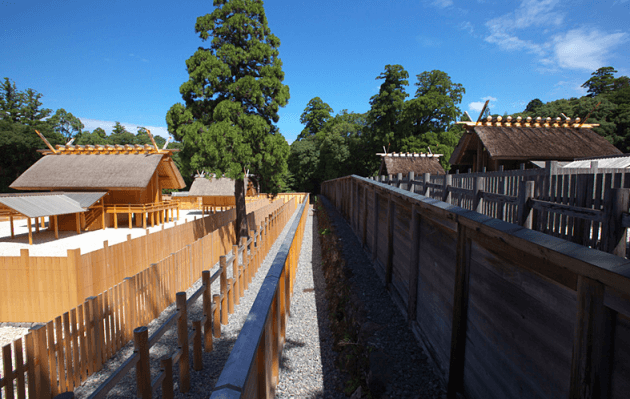
The lumberyard surrounding the Suikousya office in Arashiyama, Kyoto, is loud with the clamor of hammers and saws. A heater gently putters in the corner of the room, tempering the chill of the early spring air. Every item in the office is wood, and clearly handcrafted. I admire the perfect patterns in the woodgrain of the table as Kawai Takami draws up a stool opposite me.
Kawai began his life as a craftsman working on traditional thatched roof houses, and has since started his own company. Today, most of his time is spent working on traditional construction projects, or teaching a new generation of craftsmen about Japanese carpentry. However, he has some credentials that distinguish him from the majority of Japanese carpenters. Kawai took part in the 62nd rebuilding of Ise Shrine, a ritual process known as Shikinen Sengu. Every twenty years, the buildings, and treasures of Ise are perfectly recreated with traditional technology. This both preserves Ise itself, and the techniques that created it in the first place. Although the shrine has been a place of worship for over two thousand years, the process of rebuilding means that it is perpetually new. When I ask Kawai about what brought him to be a part of this project, he laughs.
“Believe it or not, it was a random throwaway comment that led me to Ise,” he explains. “I was working as a roof thatcher, and during one of our breaks, Shikinen Sengu happened to pop into my mind. When I mentioned that the rebuilding was coming up, one of the guys laughed and said he knew, because he was already taking part in the pre-building preparations.” Kawai chuckles as he recalls excitedly quizzing his colleague for information. The other carpenter said that he would bring up Kawai’s interest to the others involved in the preparation. However, he wrote the promise off as a joke. “I didn’t really think anything of it, until a couple of days later when they told me to submit a CV!”
Inspired and curious about Ise, he visited the shrine on a whim, and as he walked around the grounds his phone rang. Kawai muses that he is probably the only applicant to have been asked for an interview while already on site. Not long after receiving that phone call, he had passed the tests and joined the building process. It seems that there was a strand of fate drawing him towards Ise Jingu.
The lumberyard around us continues to buzz with energy as we talk, a stark contrast to the spirit of the rebuilding process Kawai describes. “The atmosphere is serious, slow and solemn,” he tells me. “All of the craftspeople work slowly but diligently.” He likens the process to a marathon that is run one step at a time. Every carpenter takes just one step every day, no more and no less. There is no room for rushing to get work done one day and relaxing the next. Instead, each day they make only small incremental advances. When I ask if this way of working is frustrating, Kawai nods in understanding and tells me, “It can be, but when your efforts are such a tiny part of a project spanning thousands of years, you learn to appreciate the importance of small steps. If you imagine that your efforts are connecting to something eternal, speed seems relative.”
The Shikinen Sengu craftsmen are in a rare situation where they are not really building for human clients. The closest thing that these artisans have to a client are the gods who reside in the structures. However, deities are not always clear on the design brief, and more often than not the craftsmen themselves are left to decide what direction to take. Kawai explains that internalizing the difference between being a good artist and a good craftsman was fundamental in dealing with this independence. “Being a good craftsman means understanding the brief and completing it exactly to the specifications,” he says. “An artist will add an extra touch, but that addition means that the brief is no longer being met exactly.” He visualizes this as a set of percentages, with anything below or above one-hundred being a failure to properly complete the task. This methodological approach to building seems to be in keeping with much of the atmosphere at Ise—slow, methodical, and almost meditative.
The idea of eternity and passing skills between generations is clearly something that has occupied a great deal of Kawai’s thoughts. In recent months he has set up a craft school for international students, and hopes to introduce Japanese carpentry techniques to an international audience. However, much of his thoughts are still with Ise. When I ask him about his future plans, Shikinen Sengu is the first thing he mentions. “I was a little late to join the building last time, so I was only a part of it for three-and-a-half years.” This meant that he missed the first half-year of the project, a time in which the bridge across the river is reconstructed. He is adamant that he will be back for the next construction project, and this time will see it from start to finish.
The work of a Shikinen Sengu craftsman will always be transient. Most artisans will only see their work standing for twenty or forty years. However, in 2025 Takami Kawai will once again cross the river to enter Ise, only this time on a bridge that he will have helped to create. He will dismantle his old work, and rebuild it once more, putting his own work to rest, but helping Ise Jingu to take one more step towards eternity.
Images from the Shikinen Sengu ceremonies can be viewed at www.isejingu.or.jp/

Originally from the UK, KJ volunteer Anna Malpas has been exploring Japan for the last six years.